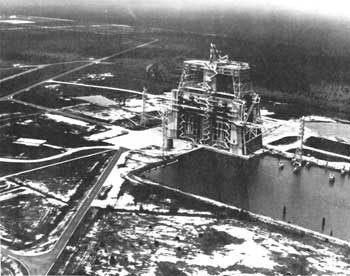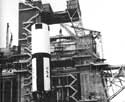.gif)
MENU
|
Man in Space
A National Historic Landmark Theme Study |

|
|
Rocket Engine Test Stands |

Aerial View of B-1/B-2 Test Stand, 1973.
(Courtesy of NASA, Marshall Space Flight Center Facilities Office)
Rocket Propulsion Test Complex
| Name: | Rocket Propulsion Test Complex A-1/A-2, B-1/B-2 (A-1/A-2, B-1/B-2 Test Stands) |
| Location: | National Space Technology Laboratories (NSTL), Bay St. Louis, Mississippi |
| Owner: | National Aeronautics and Space Administration (NASA) |
| Condition: | Excellent, altered, original location |
| Builder/Architect: | NASA |
| Dates: | 1965-Present |
DESCRIPTION
"B" Test Complex
The Rocket Propulsion Test Complex ("B" Test Complex) was constructed in 1965 to support static testing of the S-1C stage of the Saturn V rocket. The test stand is a dual position stand 407 feet tall and is constructed from steel and concrete. The test stand rests on 1600 steel pilings each 98 feet long. During test firings the S-1C stage was secured by four huge hold-down arms anchored to a slab of concrete 39 feet thick. The restraining arms clamped onto the rocket tail by means of a drive mechanism geared to move only 3 inches per minute.
In addition to the test stand, the "B" Test Complex consists of a Test Control Center, and the required technical facilities (water, electrical, high pressure gas, propellant systems, etc.) as well as the associated ground support equipment necessary to control and fire the captive stage.
The test stand is nominally rated for static testing stages with up to 7,500,000 pounds of thrust. One side of the test stand has been modified to accommodate the testing of the space shuttle main propulsion system elements (the engines, the External Tank, and a simulated Orbiter with flight propulsion systems).
A well-equipped machine shop is in the west test pier. The shop has a limited manufacturing capability used in the support of various engine or stage testing and ground support equipment.
The Test Control Center (TCC) houses the equipment and people required to control, observe, supervise, and monitor the operation of the test complex. The TCC is also a position from which technical observers can view test firings and which provides a blastproof location for test stand personnel who have vacated the stand during test firings. The TCC is capable of supporting additional stage and/or engine test stands.
The High-Pressure Gas System includes a gas battery of air, nitrogen, and helium. The propellant system includes a 300,000-gallon ready storage tank and docking and transfer facilities for the liquid propellant barges. [1]
"A" Test Complex
The "A" Test Complex consists of two single-position test stands, designated A-l and A-2, a Test Control Center (TCC), observation bunkers, technical systems (such as high-pressure gas systems, water, electrical, etc.), as well as all associated ground service equipment necessary to control and fire engines or stages involved.
Each stand is capable of static firing a stage up to 33 feet in diameter and 82 feet long. Stages of greater or smaller diameter and length can be tested by using an adapter system of modifying the stand. These stands were designed for 1,000,000 pounds of thrust although they have a capability to 1,200,000 pounds. The stand propellant systems include liquid oxygen and liquid hydrogen.
The TCC performs the same functions as the "B" TCC. It is also capable of supporting additional test stands without modifying the physical facilities.
The high-pressure gas battery contains air, helium, and nitrogen. There is a separate gas battery for the hydrogen system. [2]
The "A" Test Complex now supports engine testing for the Space Shuttle program.
STATEMENT OF SIGNIFICANCE
The National Space Technology Laboratories was established in the early 1960s as the national rocket test range for flight certifying large rocket propulsion systems. The Rocket Propulsion Test Complex ("B" Test Complex and the "A" Test Complex) were both built in 1965 to support this goal. The '"B" Test Complex supported all ground testing for the S-1C stage of the Saturn V rocket and the "A" Test Complex performed all ground testing for the S-11 stage of the Saturn V rocket.
The Saturn V rocket was one of the most reliable rockets ever built for the space program and was crucial to the effort to land a man on the moon. The success of the Saturn V was dependent upon extensive ground testing of the vehicle. Once the Saturn V lifted off the pad there was no turning back for repairs. Its powered flight was brief but critical. The economics of rocketry and the physical safety of the astronauts demanded that the rocket work perfectly. This was the purpose of the Rocket Propulsion Test Facility.
This facility was the primary site for conducting research, development and certification testing on non-flight engines to improve and upgrade basic engine design, and acceptance testing of flight engines. No Saturn V was shipped to the Kennedy Space Center until its engines were fully tested and certified. Any problem capable of causing a failure in the vehicle was discovered and corrected before the actual launch. The Rocket Propulsion Test Complex was the critical final step in certifying the first stage of the Saturn V rocket for flight.
FOOTNOTES
1. Roger E. Bilstein, Stages to Saturn: A Technological History of the Apollo/Saturn Launch Vehicles (Washington, D.C.: National Aeronautics and Space Administration, 1980), p. 207.
NSTL Facilities Master Plan (Washington, D.C.: National Aeronautics and Space Administration, 1979), p. 56.
2. NSTL Facilities Master Plan, p. 56.
BIBLIOGRAPHY
Bilstein, Roger B. Stages to Saturn: A Technological History of the Apollo/Saturn Launch Vehicles. Washington, D.C.: National Aeronautics and Space Administration, 1980.
Brooks, Courtney G., Grimwood, James M., and Swenson, Loyd S. Chariots for Apollo: A History of Manned Lunar Spacecraft. Washington, D.C.: National Aeronautics and Space Administration, 1979.
Discovering...Space-Oceans-Earth. NSTL, Mississippi: National Space Technology Laboratories. No Date.
Master Plan NSTL Facilities. Washington, D.C.: National Aeronautics and Space Administration, 1980.
Technical Facilities Catalog Vol. III. Washington, D.C.: National Aeronautics and Space Administration, 1974.
PHOTOGRAPHS
(click on the above photographs for a more detailed view)
 Top
Top
Last Modified: Mon, Jan 8 2001 10:00:00 am PDT
http://www.cr.nps.gov/history/online_books/butowsky4/space10.htm
![]()







